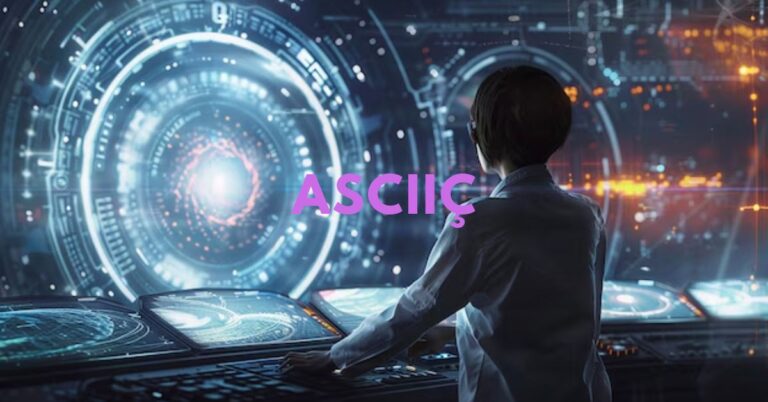Introduction to ASCII Encoding
ASCIIç is more than just a quirky combination of letters; it’s a foundational concept in the world of digital communication. Imagine typing out your thoughts and having them transformed into binary code that computers can understand! That’s the magic of ASCII encoding. As we dive deeper into this fascinating subject, you’ll discover its history, structure, limitations, and much more.
Whether you’re a tech enthusiast or someone simply curious about how our devices communicate, understanding ASCIIç will enhance your appreciation for the technology around you. Join us on this journey through text encoding as we uncover key insights that have shaped the way we interact with machines today.
The History of ASCII and Its Evolution
ASCII, or the American Standard Code for Information Interchange, emerged in the early 1960s. It was born out of a need for a universal character encoding that could facilitate communication between different devices and systems.
Initially developed by Robert W. Bemer and others, ASCII standardized data representation across computers. This allowed text files to be easily shared among varying hardware and software environments.
The original ASCII set included 128 characters, encompassing English letters, digits, punctuation marks, and control codes. As technology advanced through the decades, so did the demand for more complex character sets.
In response to globalization and diverse languages, extended versions of ASCII were created. These adaptations incorporate additional symbols needed for non-English languages—bridging gaps in communication worldwide while maintaining its core principles rooted in simplicity and efficiency.
The Structure of ASCII Code
ASCII code is built on a simple principle: each character corresponds to a unique numerical value. This system uses 7 bits, allowing for 128 different characters.
The first 32 values (0-31) are control characters. They manage text formatting and communication but aren’t visible in the final display. Think of them as unseen helpers.
Characters from 32 to 126 represent printable symbols, including letters, digits, punctuation marks, and special characters like spaces. Each of these has its designated number—making it easy for computers to interpret text accurately.
ASCII’s structure is straightforward yet effective. With just seven bits per character, it remains lightweight compared to modern encoding systems that support multiple languages and symbols. Its simplicity has contributed significantly to its enduring popularity in various applications worldwide.
Understanding this basic architecture helps appreciate ASCII’s role in computing history and ongoing relevance today.
Challenges and Limitations of ASCII Encoding
ASCII encoding, while groundbreaking in its time, has notable challenges. One major limitation is its inability to represent characters beyond the basic Latin alphabet. This includes accented letters and symbols from other languages.
As globalization surged, ASCII’s constraints became apparent. It fails to accommodate diverse scripts such as Cyrillic or Chinese characters. This can lead to frustrating data loss or misrepresentation when handling international text.
Additionally, ASCII only supports 128 unique characters. For modern applications that require a broader character set, this is simply inadequate. The rise of multimedia content further exposes ASCII’s shortcomings; it can’t handle images or complex formatting effectively.
Moreover, compatibility issues arise with newer systems and technologies that utilize more extensive encodings like UTF-8. As developers seek inclusivity in digital communication, these limitations can hinder progress and accessibility across various platforms.
Alternatives to ASCII Encoding
While ASCII has been a foundational text encoding standard, it certainly isn’t the only option available. Several alternatives have emerged to accommodate broader character sets and more complex needs.
UTF-8 is one of the most popular alternatives. It can represent every character in the Unicode standard while remaining backward-compatible with ASCII. This flexibility makes UTF-8 ideal for international applications where multiple languages may be needed.
Another alternative is ISO 8859, which includes various encodings tailored for different language groups. These versions extend beyond ASCII’s limitations but are still not as comprehensive as Unicode standards.
For specialized uses, there are formats like EBCDIC which cater primarily to IBM mainframes. Each alternative offers unique features designed to meet specific requirements across diverse computing environments.
Use Cases and Applications of ASCII Encoding
ASCII encoding plays a pivotal role in various applications. It is the backbone of text processing in computers, enabling seamless communication between devices.
In programming, ASCII serves as a fundamental character set for source code. Many languages rely on it to interpret commands and syntax correctly.
Data transmission also benefits from ASCII’s simplicity. Protocols like HTTP and FTP use this encoding to facilitate data exchange over networks efficiently.
Moreover, legacy systems often depend on ASCII due to its widespread compatibility. This ensures that older technology can still communicate with modern platforms without issues.
Text files are another common application. They utilize ASCII because it’s lightweight and universally recognized across different operating systems.
From email communications to web development, understanding ASCII opens doors to numerous technological possibilities that impact everyday digital interactions.
Conclusion
ASCII encoding remains a cornerstone of digital communication. Its simplicity and efficiency have allowed it to endure despite the emergence of more complex encoding systems. Understanding ASCII opens doors to appreciating how data is structured and transmitted in our increasingly digital world.
While it has limitations, its foundational role cannot be underestimated. Many modern technologies still rely on ASCII or draw inspiration from its principles. Whether you’re coding, working with text files, or diving into the realms of programming languages, having knowledge about ASCII can enhance your understanding and skills.
As technology evolves, so do our methods for handling text and data representation. Exploring alternatives can provide solutions that meet specific needs while keeping the essence of what makes ASCII valuable intact.
ASCII continues to find relevance today; recognizing this legacy helps us appreciate both the past and future of text encoding. The journey through its history enriches our comprehension as we navigate an ever-changing technological landscape.
FAQs
What is ASCIIç?
ASCIIç (American Standard Code for Information Interchange) is a character encoding standard that assigns numerical values to characters, symbols, and control codes. It allows computers to interpret and exchange text consistently across different systems.
How does ASCIIç work?
ASCIIç uses a 7-bit system to encode 128 characters, including control codes and printable symbols. Each character is represented by a unique number, facilitating accurate text processing and communication in computing.
What are the limitations of ASCIIç?
ASCIIç is limited to 128 characters, which includes only basic Latin letters, digits, and symbols. It does not support characters from other languages or complex symbols, leading to challenges in global text representation.
What are some alternatives to ASCIIç?
Alternatives like UTF-8 and ISO 8859 extend the character set beyond ASCIIç, accommodating multiple languages and symbols. UTF-8 is widely used for its backward compatibility with ASCIIç and support for a broad range of characters.
How is ASCIIç used in modern technology?
Despite its limitations, ASCIIç remains integral to various applications such as text files, programming, and data transmission. Its simplicity ensures compatibility with many systems, and it often serves as a foundation for more complex encoding standards.

